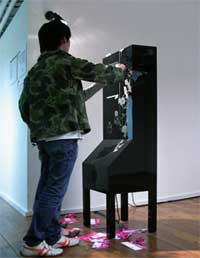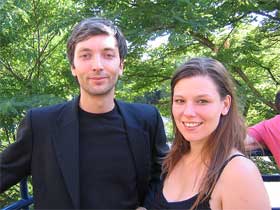 Just back from We Love Technology which took place yesterday in Huddersfield. Everyone seemed to have a great time there. Perfect organization, lovely picnic in the park, great presentations by brilliant speakers, fun workshops in the afternoon and lovely evening at the Media Centre.
Just back from We Love Technology which took place yesterday in Huddersfield. Everyone seemed to have a great time there. Perfect organization, lovely picnic in the park, great presentations by brilliant speakers, fun workshops in the afternoon and lovely evening at the Media Centre.
In the afternoon two members of Troika, Eva Rucki and Sebastien Noel, presented their works. You have probably read about their projects all over the blogosphere over the past few months.
Troika is based in London and its activities encompass three areas that sometimes overlap each other: art, design and communication. Like many individuals or groups operating in the same field they regard themselves as neither designers nor artists but rather as something in-between. They work on both commissioned projects (such as an upcoming book for the publisher Thames and Hudson on creative misuses of technology) and self-initiated projects that use creative technologies to make communication tools for the public to experience. They observe how far they can go with such experimental ideas and how the public reacts to them. Mnay projects start on the Art platform and slowly glide to the Communication platform.
They gave a brief presentation of their projects:
The SMS Guerilla Projector
A handheld projector with integrated mobile phone that enables users to project something very private, SMS, in public. The original idea was to make a movie gun and shoot people with films. It doesn’t compete with a projection truck in terms of strength and quality of image but you can bring it anywhere you want and move from place to place very quickly and easily. A big lens is mounted on the device so you can screen very personalized messages from a distance. They tested the system several times in central London to see the reaction of the people. For example, they projected from the street messages about value, wealth or security inside the home of people, in London’s richest areas. After 10 minutes, police vans arrived. But the police didn’t know what to look for, no one expects a projector to be so mobile. Troika tried to experiment with images as well but found out that, for this particular project, texts are more powerful.
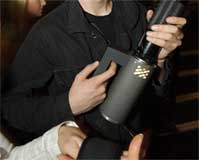
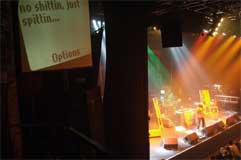
Troika was invited to make SMS Guerilla projections for ‘The Streets’ concert in London’s Astoria.
Tools for Armchair Activists
Was a kind of follow up of the SMS Guerilla projector. The tool can be strapped on lampposts and allows activists to rant from the comfort of their home. The machine is able to receive incoming sms messages and speak them out loud through its powerful megaphone. It’s completely autonomous, the human touch is removed. The message you send is read by a speech synthesis voice. It has no passion and is strikingly neutral in such context.
An aspect very important to Troika is the appearance of the device. Sebastien explained how he was a guest lecturer at Interaction Design (RCA, London) and was amazed to find mainly boxes with electronics, lumps of metals and wires with no care for the aesthetic of it. However, as he underlines, the first interaction one has with an object is its appearance. The shape is the story that an object tells us at first glance. Make something ugly and messy and chances are that you’ll immediately loose the interest of most people.
A really amusing moment for Troika was when the Tool for Armchair Activists was posted on a blog for activists. A long and heated discussion followed as commenters were taking the idea very seriously: “Can technology be used for activism? Remote activism is cheating, etc.)
One of their most recent projects, this punchcard music box turned melody shredder is less socially engaged. They love the look of Victorian technology and illustrated what they meant by that with a series of examples: the Cat Piano by Athanasius Kircher; acoustic plane detectors in Japan, etc. These devices were fascinating, you could see how they worked from the outsides. They were miles away from our perfectly smooth and glossy gadgets. And they very quirky. A place for quirkiness should be found again.
Users select a melody and receive a flyers that correspond to that melody. They are invited to tear off bits of the flyers and according to the way they destroy the piece of paper, the notes that correspond to that segment of paper are re-shifted. The look of the machine is meant to be non-threatening and has been designed for people who wouldn’t normally engage with technology. Many people are still scared by technology. Another interesting aspect is that the system allows people to destroy in order to create. Plus, destroying a famous melody is quite irresistible and satisfying. People were also asked to leave the flyers on the floor when they had finished: it was messy and meant to look like a Greek party where you smashed the plates. The mess was a tangible trace of the experience people had with the instrument.
That project gives a human and sensual approach to data. Our world is governed by data, we’re immersed in it but we don’t know how it sounds like for example. The Datasound turntable reads floppy disks, family pictures, tube tickets, credit cards and directly amplifies the data. Troika found the experience very playful but its variations were somewhat limited.
The instruments give access to the hidden language of objects. They can hear any magnetic field (Bluetooth, wifi, etc.) and allows to understand the internal working of the machines. Similar systems are use to detect which component is failing when, say, a computer crashes.
They showed the work in an installation (called “Shit! I forgot the iPod!”) in Germany. All the electronic devices one can find in a house were packed in a room. From toaster to fan, from TV set to fridge. People listening through the electroprobe headphones were very surprised as the devices were not sounding as they would have expected. The TV, for example, is extremely noisy. It’s also amusing to hear how different the noises can be from one another: some buzz, other make more “clicketyâ€? noises, etc.
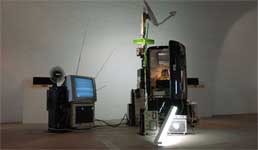
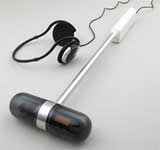 Shit! I forgot the iPod! and an electroprobe
Shit! I forgot the iPod! and an electroprobe
The Troika guys like dysfunctionning technology: glitches, bugs, virus, crashes. The devices that surround ourselves, the object to which we delegate more and more power are sometimes faulty. This makes them nearly “human.�
Newton Virus introduces a very physical element inside your computer: gravity. It causes the desktop icons to fall down as if subject to the gravitational pull from the real world. You can affect manually the computer of your friend and see how they react.
We want our object to be “smart�, we want them to copy human intelligence. What if these objects were assuming other human characteristics: greed, jealousy, lust, etc?
The picture frame is jealous of the attention that the TV set receives everyday: So it attacks the TV by infra red. As time passes, its behaviour becomes more and more annoying and nasty: it suddenly turns the colours of the image to B&W; it raises the sound at full volume in the middle of the night, it records programs you don’t want on your VCR.
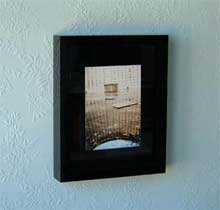
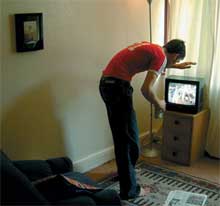
Sebastien explained how he installed the picture frame at this dad’s house and watched how the poor man was getting more and more puzzled, then finally had to call the repairman. He never dared to tell the truth to his father.
Where does the name Troika come from? It means “three� in russian. There are three members of Troika (Sebastien Noel, Conny Freyer and Eva Rucki), their works cover three areas (communication, art and design) and they were working on a book about Moscow at the time when they had to find a name for their studio.
Images on flickr.

